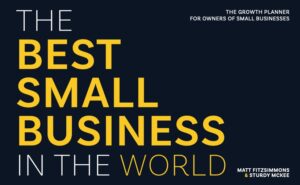Greg Crabtree lays out what he calls “The Four Keys” in Section 1 of his book, Simple Numbers, Straight Talk, Big Profits!.
I wrote a summary of those “4 Keys”, but what I failed to include in that summary was Crabtree’s idea that you should backwards plan your budget. It’s kind of buried in the chapters’ 2 & 3 summaries, but I want to call it out explicitly.
You have a going concern, or are  designing your business that you wish to start. Crabtree says, and I whole-heartedly agree by the way, that you should start with your desired profit. Whether you begin with a percentage or a hard number, begin with the profit you wish to make. Decide on 10%, 15%, 20%, 18%, or whatever you think is reasonable as an owner/shareholder. Remember that this profit is calculated AFTER you pay yourself your replacement salary. If you are working in the business it is important to pay yourself a salary for the work you actually do. (See Ch. 1.)
designing your business that you wish to start. Crabtree says, and I whole-heartedly agree by the way, that you should start with your desired profit. Whether you begin with a percentage or a hard number, begin with the profit you wish to make. Decide on 10%, 15%, 20%, 18%, or whatever you think is reasonable as an owner/shareholder. Remember that this profit is calculated AFTER you pay yourself your replacement salary. If you are working in the business it is important to pay yourself a salary for the work you actually do. (See Ch. 1.)
Plug your profit number into a grid like the one below, putting your gross revenue or Annual Cash Flow at the top. From that number you can calculate the percentage or the dollar amount depending on how you started out with your desired profit.
For this illustration we are using $1 million in Annual Cash Flow and a desired profit of 18% to begin with.
| Annual Cash Flow | $1,000,000.00 | |
| Overhead Expenses | ||
| Personnel Expenses | ||
| Profit | $180,000.00 | 18.0% |
Once you have your profit entered, along with your Annual Cash Flow number, plug your overhead into the grid and calculate the percentage. If you have a going concern, you will be able to pull your actual, current Overhead Expenses from your bookkeeping software. For our purposes your overhead is everything not personnel related. It includes items like rent, utilities, supplies, equipment leases, insurance (not related to personnel like workers’ comp), IT, janitorial, and anything else you are spending that is not related to your staff.
You can see here that we’ve calculated Overhead Expenses at 29% for this illustration.
| Annual Cash Flow | $1,000,000.00 | |
| Overhead Expenses | $290,000.00 | 29.0% |
| Personnel Expenses | ||
| Profit | $180,000.00 | 18.0% |
What Crabtree says is that what is left is your “Salary Cap” for your Personnel Expenses (See Ch. 3.) Just understand that for this calculation this is ALL the money that you have available to spend on staff. It includes workers’ comp insurance, payroll taxes, benefits expenses, and anything else related to employing your team.
So you have 53%, or $530,000, per year to put toward total compensation for all of your staff, including yourself.
Annual Cash Flow = Overhead Exp + Personnel Exp + Profit.
In this case $1,000,000 = $290,000 + $530,000 + $180,000, or
100% = 29% + 53% + 18%
Your Profit, Overhead Expenses, and Personnel Expenses cannot exceed 100%. If you overspend on your Overhead Expenses or Personnel Expenses, then that comes out of your Profit.
| Annual Cash Flow | $1,000,000.00 | |
| Overhead Expenses | $290,000.00 | 29.0% |
| Personnel Expenses | $530,000.00 | 53.0% |
| Profit | $180,000.00 | 18.0% |
This is the reverse order most people use to create a budget. They say things like “Profit is what is left over”. But this is all wrong. This feels like leaving things to fate when you are the person in charge of your budget.
Profit is what you make as an investor, knowing that you may choose to use part of it to reinvest in your business, or to build reserves or service debt. Some of it will go to taxes. But some going to taxes means you made an actual profit, so celebrate that.
You now have a budget to compare against your spending in order to preserve your profit. This is true whether you are at capacity or if you want to grow. You have a budget you can use in the 5th Critical Process of your business.
So give this go, and then make sure to review all 5 Critical Processes in your business.
Join us over at the Focus Forward Starter Group to discuss this and other business topics. And make sure to pick up Greg’s book, “Simple Numbers”.
Have questions about this or any other business challenges you are facing? Book a Conversation with Sturdy.
